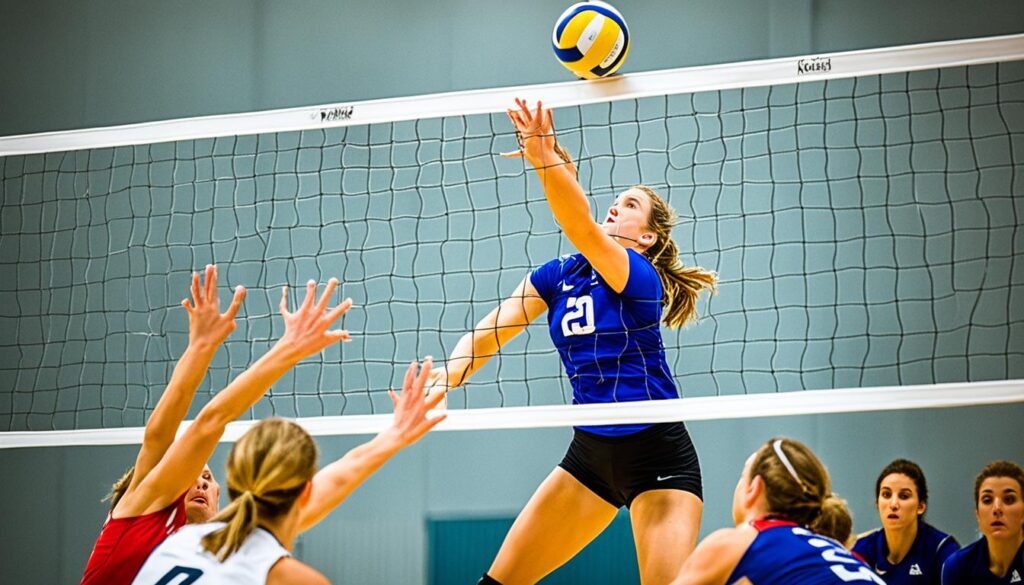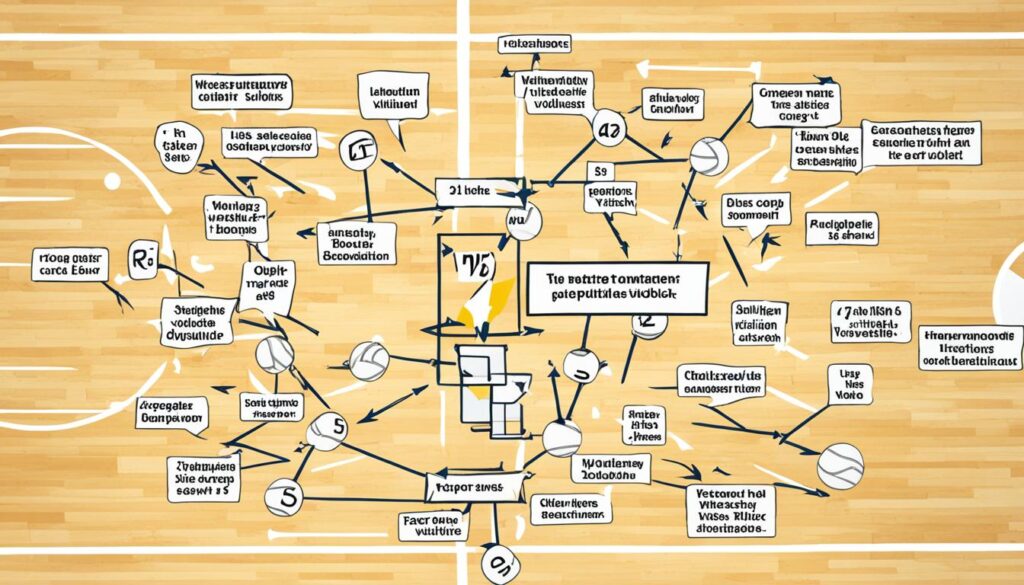Whether you’re a beginner or an experienced player, mastering the fundamental volleyball techniques is crucial for success on the court. From serving to hitting, passing to blocking, and digging to setting, each skill plays a vital role in contributing to your team’s performance. By focusing on proper technique and regular practice, you can elevate your game and become a more well-rounded player.
Key Takeaways:
- Mastering essential volleyball techniques is crucial for all players, regardless of their level of play.
- Skills like serving, passing, setting, hitting, blocking, and digging are the key building blocks of the game.
- Regular practice and proper technique are essential for honing these skills and improving your performance.
- Understanding the rules and terminology of volleyball is important for effective communication and gameplay.
- By dedicating yourself to improving these skills, you can take your volleyball game to new heights and enjoy the sport to the fullest.
Serving Techniques in Volleyball
In the game of volleyball, serving is a fundamental skill that can greatly impact the outcome of a match. Whether you’re a beginner or an experienced player, understanding and mastering different serving techniques is essential. This section will explore the key techniques for serving in volleyball, including the float serve and the jump serve.
Float Serve
The float serve is a serve that lacks spin and is designed to confuse the opposing team’s reception. To execute a float serve effectively, players should follow these key steps:
- Stand in a balanced position with feet shoulder-width apart.
- Toss the ball in front of the serving shoulder, ensuring a consistent and accurate toss.
- Keep the elbow high and back, generating power and control.
- Contact the middle of the ball with the middle of the hand, avoiding excessive spin and adding unpredictability to the trajectory.
- Follow through on the armswing, maintaining a fluid motion and transferring energy into the serve.
Developing a consistent pre-serve routine can also help players focus and prepare mentally before serving.
Jump Serve
The jump serve is a more advanced serve that involves jumping to generate power and spin. Here are the fundamental steps for executing a jump serve:
- Start with a quick approach, using a few quick steps to build momentum.
- Jump off both feet, timing the jump to maximize height and power.
- Toss the ball high above the head, allowing for a longer contact window.
- While in the air, position the serving arm back and the opposite arm forward, creating torque for spin.
- Contact the ball at the highest point of the jump, aiming for the intended target.
- Follow through with the armswing, extending the hitting arm toward the target and generating power.
The jump serve is known for its speed and power, making it a formidable weapon in the game of volleyball.
| Technique | Advantages | Disadvantages |
|---|---|---|
| Float Serve | – Difficult to pass accurately – Creates confusion for the opponent – Can disrupt the opponent’s offense |
– Requires control and accuracy – Becomes predictable if not varied |
| Jump Serve | – Generates power and spin – Forces the opponent to react quickly – Creates scoring opportunities |
– Requires athleticism and timing – Higher risk of serving errors – Demands practice to perfect |
By mastering both the float serve and the jump serve, players can add variety to their serving repertoire and become more effective in challenging their opponents. Practice and consistency are key to developing proficiency in these techniques.
Passing Techniques in Volleyball

Great passing is essential for a successful volleyball team. Proper body position and technique play a crucial role in executing accurate passes. To improve passing skills, players should focus on the following techniques:
- Body Position: Maintain a level center of gravity when moving to ensure stability and balance.
- Forearm Pass: Form a solid platform by clasping the wrists together and creating a flat surface with the forearms.
- Hips and Legs: Utilize the power from the hips and legs to generate force and control the pass.
- Quick Positioning: Concentrate on getting into a stable position quickly after moving to be ready for the pass.
Additionally, players can employ overhead passing techniques in specific situations. This technique involves using the hands to set the ball. It is useful for precise placement and controlled passes. Overhead passing requires proper hand positioning, soft touch, and coordination.
Essential Passing Techniques:
| Technique | Description |
|---|---|
| Body Position | Maintain a balanced and square stance with knees flexed while facing the target. |
| Forearm Pass | Create a platform with the forearms by locking the wrists and contacting the ball with the forearm muscles. |
| Hips and Legs | Engage the lower body to generate power and control, utilizing leg drive and hip rotation during the pass. |
| Quick Positioning | React swiftly to the ball’s trajectory, move into position early, and establish a stable base before passing. |
| Overhead Passing | Use the hands to set the ball, employing a soft touch and proper hand placement for controlled and accurate passes. |
“Passing plays a fundamental role in volleyball, providing the foundation for successful offensive attacks. Mastering passing techniques allows players to make accurate and consistent passes, setting up their teammates for powerful hits. Focus on technique and practice regularly to improve overall passing skills.” – Coach Anna Thompson
Setting Techniques in Volleyball

Setting is a critical skill for volleyball setters, and mastering proper techniques can significantly enhance their performance on the court.
Setters should focus on:
- Getting to the target
- Being ready to move from the target
- Anticipating where the ball will be passed
- Beating the ball to the spot
- Stopping and setting the ball with proper footwork
- Transferring weight from the left to the right foot
When setting, setters must first establish good footwork. They should position themselves in front of the target area and maintain an athletic stance with slightly bent knees and their weight balanced between both feet. This ensures quick and efficient movements.
Anticipation is a key aspect of setting. Setters should read the game situation and analyze the ball trajectory to position themselves in the right spot before the ball arrives. This skill comes with experience and allows setters to be in position to deliver accurate sets to their teammates.
Once in position, setters must use proper footwork to stop and set the ball. The stop-and-set technique involves stopping abruptly with both feet while simultaneously extending the arms and wrists to release a controlled and accurate set. This coordination between footwork and arm movement is crucial for consistency and precision.
It is important to note that setters must maintain good balance and body control throughout the entire setting process to ensure accurate and consistent sets for their teammates’ attacks.
By practicing these setting techniques, setters can become more effective playmakers, greatly contributing to their team’s success.
Setting Techniques for Different Types of Sets
In addition to the basic setting techniques mentioned above, setters should also master various types of sets to maximize their team’s offensive options. Some common types of sets include:
| Type of Set | Description |
|---|---|
| Push Set | A quick and low set used close to the net to surprise the opposing blockers. |
| High Set | A lofty set used for middle or back-row attackers to jump and attack at a higher point. |
| Backset | A set delivered to a hitter who is behind the setter, creating an angle that confuses the blockers. |
| Bic Set | A back-row quick set to the middle hitter, executed by a reverse spin on the ball. |
| Shoot Set | A quick set delivered to an attacker on the move, allowing them to hit the ball at its highest point. |
The ability to execute different types of sets showcases a setter’s versatility and can keep the opposing team guessing, creating scoring opportunities for their own team.
Hitting Techniques in Volleyball

A strong hitting technique is crucial for attackers in volleyball. To maximize their effectiveness on the court, players should focus on developing consistent footwork, employing the correct approach, perfecting their armswing, and making solid contact with the ball.
Footwork and Approach
Footwork and approach play a significant role in a successful hit. Players should utilize a 3 or 4 step approach, focusing on maintaining a consistent rhythm and timing. The last two steps of the approach are particularly important for generating maximum jump height and power.
Armswing
The armswing is a key component of a strong hit. It involves swinging the arms back as the player begins their approach, bringing both arms up as they jump, and finally, extending the hitting arm and contacting the ball in front of the hitting shoulder. A smooth and powerful armswing contributes to a more forceful hit.
Contact
Making proper contact with the ball is vital for a successful hit. Players should aim to hit the ball with a firm and controlled hand, ensuring contact is made with the desired part of their hand to achieve the desired trajectory and control. Additionally, adding top-spin to the ball can provide attackers with better angles for hitting.
By incorporating these hitting techniques into their gameplay, volleyball players can develop a strong hitting approach that allows them to deliver powerful and precise attacks to their opponents.
Blocking Techniques in Volleyball

Blocking is a defensive play in volleyball that requires good court vision and quick decision-making. When it comes to blocking, players need to focus on watching the setter, the ball, and the hitters to get in the best position to block.
One essential technique for effective blocking is the shuffle step. The shuffle step allows players to move laterally on the court and adjust their position based on the setter’s movements. By shuffling their feet, blockers can quickly react and position themselves to block the ball.
Another important technique is the crossover step. The crossover step helps players change direction and move towards the hitting area. By crossing their back foot over their front foot, blockers can quickly transition from shuffling to moving forward, ensuring they are in the optimal blocking position.
When executing a block, it’s crucial for players to jump straight up to maximize their reach and disrupt the hitter’s attack. Additionally, players should aim to penetrate the net and take up as much space as possible. This can be achieved by extending their arms and hands wide, with their fingers and thumbs pointing up.
Here’s a quick overview of the key blocking techniques:
- Watch the setter, the ball, and the hitters
- Utilize the shuffle step to adjust position laterally
- Execute the crossover step to move towards the hitting area
- Jump straight up to maximize reach
- Penetrate the net with wide fingers and thumbs up
By mastering these blocking techniques, players can effectively defend against the opponent’s attacks and create opportunities for their team to score.
| Blocking Techniques | Description |
|---|---|
| Shuffle Step | Moving laterally to adjust position based on setter’s movements |
| Crossover Step | Changing direction and moving towards the hitting area |
| Straight Up Jump | Jumping vertically to maximize reach |
| Penetration | Extending arms and hands wide to take up space at the net |
Digging Techniques in Volleyball
The defensive play of digging is essential for keeping the ball in play and initiating offensive attacks in volleyball. By employing proper digging techniques, players can effectively receive hard-driven balls and prevent them from hitting the ground.
One of the first considerations for successful digging is positioning. Players should start in a defensive stance, up on their toes and on the balls of their feet, ready to react to the incoming ball. Being in the correct defensive position allows players to move quickly and maintain balance while executing the dig.
Cushioning the ball is another critical aspect of digging. When faced with a hard-driven ball, players must cushion the impact to ensure a clean and controlled pass. By slightly absorbing the force of the ball with their forearms, players can redirect it to their intended target and keep it in play.
Furthermore, staying on the feet whenever possible is recommended during digging. While diving may be necessary in certain situations, a player who can dig while remaining on their feet has more options available. They can quickly respond to unexpected plays or set up an offensive attack with greater efficiency.
In emergency situations where the ball is diving toward the ground, players must be prepared to make extreme defensive plays. There are several techniques that can be used depending on the situation. These include collapse, sprawl, dive, or pancake techniques, each designed to save the ball from touching the ground and maintain the rally.
In the words of legendary volleyball player Misty May-Treanor, “Digging is all about reaction time, technique, and being fearless.”
| Technique | Description |
|---|---|
| Collapse | Quickly drop to the knees and elbows to make a last-ditch effort to keep the ball off the ground. |
| Sprawl | Extend the body horizontally while keeping the feet off the ground, using the forearms and hands to dig the ball. |
| Dive | Extend the body fully and dive to the ground, using the forearms and hands to dig the ball. |
| Pancake | Press the back of the hand and forearm flat on the ground, sliding it under the ball to lift it off the ground. |
Volleyball Rules and Terminology

Having a solid understanding of volleyball rules and terminology is essential for players, coaches, and spectators. Familiarity with these rules and terms not only ensures fair play but also promotes effective communication and gameplay strategies. Here are some key aspects of volleyball rules and the terminology commonly used in the sport:
Volleyball Rules
The following are some of the fundamental rules that govern the game of volleyball:
- Rally-Point Scoring: Volleyball games are played using the rally-point scoring system. This means that a point is awarded for every rally won, regardless of the team that served the ball.
- Maximum of Three Hits: Each team is allowed a maximum of three hits to return the ball over the net. This includes the initial receive, the set, and the attack.
- Net Violation: Touching the net during play is considered a violation and results in a point being awarded to the opposing team.
Volleyball Terminology
To effectively communicate and strategize during a volleyball game, it’s important to be familiar with the common terminology used in the sport. Here are some key terms:
| Term | Definition |
|---|---|
| Ace | A serve that lands in the opponent’s court untouched and earns a point. |
| Block | A defensive move by a player or players to intercept and stop the attacking ball. |
| Back Row Attack | An attack made from behind the three-meter line by a back-row player. |
| Kill | A successful attack that results in an immediate point for the attacking team. |
In addition to these terms, there are various other volleyball-specific words and phrases that players and enthusiasts should become familiar with to enhance their understanding and enjoyment of the game.
Understanding the dimensions of the volleyball court and the scoring system is also essential. Note that court dimensions and scoring systems may vary depending on the level of play. Consult the official rulebooks for specific details.
Volleyball, a popular sport worldwide, has a rich history that includes both men’s and women’s teams competing at various levels, from local volleyball clubs to international tournaments like the NCAA Women’s Volleyball Championship. The game originated in the United States, where William G. Morgan first introduced it as “mintonette” in the late 19th century. Over time, volleyball evolved into an official sport, with the Fédération Internationale de Volleyball serving as the governing body.
Today, volleyball is played on both indoor and sand courts, with teams consisting of six players each, including positions such as outside hitters and middle blockers. The objective is to return the ball over the net and score points by landing it within the opposing team’s court boundaries. Matches are typically played in a best-of-five sets format, with the first team to score 25 points (by a two-point margin) winning a set. Volleyball has also been adapted for sitting volleyball, which is included in events like the Summer Paralympics. As the sport continues to grow, upcoming events like the Summer Olympics provide a platform for national teams to showcase their skills and compete for the podium. With its fast-paced action and dynamic gameplay, volleyball remains a beloved sport enjoyed by players and fans around the world.
Also Read : Indoor Sports: Fun Activities For All Ages
Conclusion
In conclusion, volleyball is an exhilarating sport that demands skill, technique, and teamwork. By honing the essential techniques of serving, passing, setting, hitting, blocking, and digging, players can elevate their performance on the court and contribute to their team’s success. However, it is equally important to grasp the rules and terminology of the game to effectively communicate and execute strategies.
With consistent practice and dedicated effort, players of all levels can enhance their volleyball skills and find immense enjoyment in the sport. From perfecting the serve to executing powerful hits, every facet of the game requires discipline and determination. Moreover, understanding the intricacies of volleyball enables players to come together as a cohesive unit and achieve synergy on the court.
As players continue their volleyball journey, they should remember the key takeaways from this article – the emphasis on technique, the significance of teamwork, and the impact of dedicated practice. By implementing these principles, players can unlock their full potential and truly excel in the exciting world of volleyball.
FAQs
Q: What are some essential volleyball tips for beginners?
A: Beginners should focus on learning proper serving techniques, mastering basic passing and setting skills, and understanding the rules of the game. It’s also crucial to work on footwork and positioning on the court.
Q: How can I improve my volleyball techniques?
A: Improving your volleyball techniques involves consistent practice, seeking guidance from experienced coaches, and participating in skill-specific drills. Additionally, watching and analyzing professional matches can provide valuable insights.
Q: Is there any specific training required for advanced volleyball players?
A: Advanced players should focus on enhancing their agility, power, and speed. Implementing advanced strategies, such as effective blocking and attacking techniques, and honing their decision-making skills in high-pressure situations are also crucial.
Q: What is the significance of teamwork in volleyball?
A: Teamwork in volleyball is essential for success. Players need to communicate effectively, support each other on the court, and understand their teammates’ strengths and weaknesses to maximize their collective performance.
Q: Where can I find information about upcoming volleyball tournaments and events?
A: Information about upcoming volleyball tournaments and events can be found on official volleyball association websites, as well as through reputable sports news outlets. Additionally, social media platforms and local sports organizations may provide updates on volleyball competitions.
Q: How can I become a part of the national volleyball team?
A: To become a part of the national volleyball team, aspiring players can participate in tryouts organized by the national volleyball association or affiliated clubs. Consistently demonstrating exceptional skills and commitment can increase the chances of being scouted for the national team.
Q: What is the significance of the Olympics in the world of volleyball?
A: The Olympics serve as a prestigious platform for volleyball, allowing the world’s best players to compete on an international stage. The event not only promotes the sport but also inspires aspiring volleyball athletes and unites fans from around the globe.
Q: How does volleyball contribute to physical fitness?
A: Volleyball is an excellent full-body workout that promotes cardiovascular health, muscular endurance, and agility. It also enhances coordination, reflexes, and overall physical conditioning, making it a great sport for boosting fitness levels.
Q: What are the key elements of successful volleyball strategies?
A: Successful volleyball strategies involve effective communication, strategic positioning, quick decision-making, adaptability to opponents’ tactics, and the ability to capitalize on scoring opportunities. Coordinated plays and dynamic teamwork are also vital for executing successful strategies.
Q: Can volleyball be played at different skill levels?
A: Yes, volleyball can be played at various skill levels, ranging from recreational and amateur levels to professional and international competitions. The sport caters to players of different abilities, providing opportunities for skill development and competitive play at all levels.





